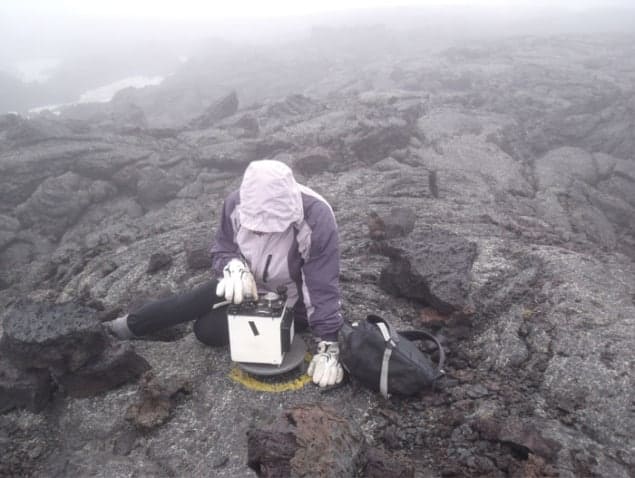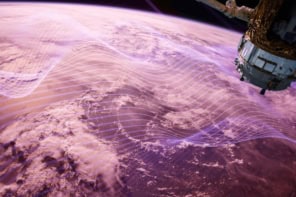Hazel Rymer reviews Island on Fire: the Extraordinary Story of Laki, the Volcano that Turned Eighteenth-century Europe Dark by Alexandra Witze and Jeff Kanipe

I wanted to dislike this book. After all, there are so many books out there about volcanoes already. Did we really need another? But Island on Fire is interesting. It focuses on one particular eruption, rather than volcanoes in general, and it also investigates what the consequences would be if such an eruption were to happen again. Using accounts written during the eruption itself, Island on Fire documents the evolution of an important event in volcanic history through the eyes of those who experienced it.
The eruption in question is not a well-publicized one such as that of Vesuvius in 79 AD, Mount St Helens in 1980, Montserrat in 1995 or even Eyjafjallajökull in 2010. Nor is it some mysterious event that happened millions of years ago. Rather, it is a “forgotten” eruption that took place in 1783 – which, while obviously not within living memory, certainly feels a lot closer to home. The eruption of the Icelandic volcano Laki in that year was not the first to have an impact far beyond the island itself, and it would certainly not be the last. But unusually for an historic eruption, we have a very detailed eyewitness account of its effects.
Much of what we know about the 1783 Laki eruption comes from the writings of Reverend Jón Steingrím-sson – an early volcanologist, natural scientist and priest whose parish lay directly in the path of the eruption. His story forms a central part of Island on Fire. Beginning on 8 June 1783, Steingrímsson observed the changing mood of the volcano as earthquakes heralded a rise in river levels; a cloud of “vog”, or volcanic smog, settled over the island; ash fell from the sky; and finally lava began flowing down the valleys on Laki’s flanks. Over a period of a month, numerous villages and farms in the surrounding area were destroyed by lava flows or covered in ash, and by 20 July 1783 it looked as though the lava would next consume Steingrímsson’s own village of Klaustur and the chapel where he preached. On that day – a Sunday – he preached for rather longer than usual, leading the congregation in prayers that the village and people would be spared. When the service was over and they went outside, they saw that the lava had stopped advancing. As a result of this apparent miracle, Steingrím-sson became a celebrity and was dubbed the “Fire Priest”.
We now know that this episode marked a change in the activity at Laki, and that while Klaustur was indeed spared from the lava flows, the devastation was far from over. In the months that followed, Steingrímsson continued to document the effects of the eruption on local people and their livelihoods, including the horrific poisoning of both animals and humans by volcanic fluorine, which could be inhaled or ingested with the ash. By the end of the eight-month eruption, half of Iceland’s livestock and 20% of its human population were dead.
Today, Steingrímsson is well known not only in Iceland, but also in volcanological circles worldwide thanks to his careful documentation of the progress of the eruption and its effects. And like Steingrímsson’s reputation, the consequences of Laki’s eruption were not confined to remote farms and villages in Iceland. The outside world first heard of the eruption after travellers to the island returned to Europe or the Americas, but by then, people in those places were already experiencing their own unusual and ghastly phenomena.
Between 17 and 23 June 1783, a mysterious warm haze began drifting across northern parts of the UK, Scandinavia and eventually much of central Europe, engulfing the area in an acidic mist that scorched crops. The haze extended from sea level up to at least 3000 m, where it was reported by shepherds in the Dauphiné Alps. It smelt sulphurous and left a bitter aftertaste. Occasionally, ash fell through the haze and was spotted as far away as Venice. By July the haze had reached the Altai Mountains in Asia, and there are reports of a severe dry fog in central China. Records from South America and Alaska likewise suggest strange happenings that summer.
These unusual weather conditions led to sudden and violent thunderstorms and floods, followed by an unusually severe winter in both Europe and the US. The American scientist Benjamin Franklin, who spent some time in France during the worst of the haze and then returned to the US in time to endure the cold winter, was apparently the first to suggest that these unusual phenomena might be connected to the eruption in Iceland. Even more astutely, Franklin also suggested that if it could be shown that hard winters in the past were preceded by hot summers, there might be scope to make preparations if this were to happen again. This is probably the first recognition of a link between volcanoes and climate change.
The effects of the Laki eruption were widespread and devastating. Estimates of the death toll range from a conservative 9350 to a cool 6 million, and there is even speculation that the combination of harsh winters, cool summers and the inevitable crop failures that followed were catalysts for the French Revolution in 1789. By comparison, the air-travel chaos caused by the rather small and short-lived eruption of another Icelandic volcano, Eyjafjallajökull, in 2010, seems insignificant.
Events like the 1783 eruption of Laki have happened before and they will happen again. The big difference now is that we are very much more vulnerable than we were in the 18th century. While the complete systems breakdown that followed the 2010 Eyjafjallajökull eruption was annoying, the brevity of that eruption made a speedy recovery possible. But the 1783 Laki eruption lasted for months, and a similar eruption could last even longer. Extrapolating the impact that such an eruption would have today makes for gloomy reading.
There is no way of preventing such natural hazards. We can only try to mitigate the worst of their effects through better preparedness and by improving our understanding of the precursory signals. Island on Fire is an enjoyable and informative read, and it provides a timely reminder of how essential it is to improve our understanding of volcanic processes.
- 2014 Profile Books £10.99hb 224pp



